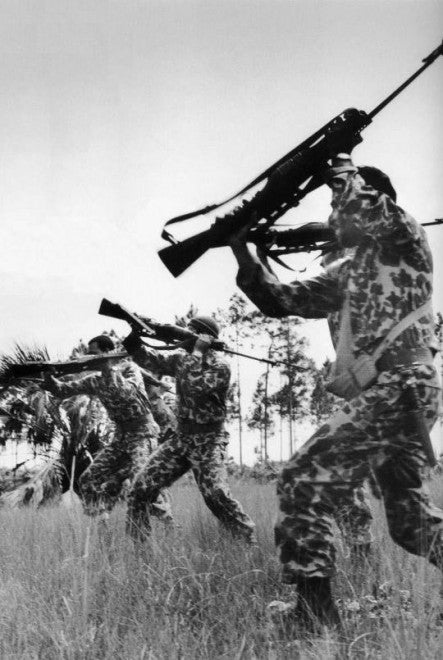Fifty-four years ago plus five days, nearly thirteen hundred troops of the paramilitary Cuban exile group Brigade 2506 landed in Cuba, in an attempt to overthrow the Communist Cuban government, led by Fidel Castro. Sponsored by the CIA, the Brigade was armed with a motley of weapons, many ex-US military examples left over from World War II. Historical Firearms has posted to their Facebook page an album of photographs showing a cross-section of the weapons used by both the Brigadiers and the Communist forces.

The Communist Fidel Castro and his men holding captured US arms from the failed invasion of the Bay of Pigs, including a Johnson M1941 rifle. Image source: historicalfirearms.info
One curiosity present in the photographs is the M1941 Johnson selfloading rifle. HF takes a closer look at the Johnson and its use in the Bay of Pigs Invasion in a blog post:
The M1941 was however rejected by the majority of the US military as tooling and production of the M1 Garandhad already begun in 1937. With the outbreak of World War Two and America’s involvement from 1942 some parts of the US Marine Corps become interested in the rifle. 30.000 M1941s had originally been ordered by the Netherlands for their colonial forces, these were requisitioned and issued to the Marines. They saw some limited use during the early stages of the Pacific Campaign but were soon replaced with the more plentiful M1 Garandand the majority of the requisitioned M1941s were returned to the Dutch after the war.
However, a number remained in store throughout the 1950s and it was these rifles which would be issued to the men of Brigade 2506. In the photograph above they have their bayonets fixed and are carrying out close quarter combat drills. The M1941s bayonet as can be seen above is a type of spike bayonet, this made it useful for little else. The lighter bayonet was issued as the standard knife bayonet, as used by the M1, was found to adversely affect the rifle’s recoil-operated firing mechanism.
The Bay of Pigs Invasion was a fiasco, the unsupported Brigade 2506 landed with a total force of 1,300 and were quickly overwhelmed by Cuban forces who were much better armed. It had been hoped that a uprising of the dissatisfied would occur as soon as forces landed but this was not the case and within a day or so the Cuban army and militia was quickly boxing in the anti-Castro forces. Support from US forces, which had been hoped for, did not materialise and other than some Combat Air Patrols flown to intimidate Cuban forces, there was no sanctioned US involvement.
Of the initial landing force some 1,100 were captured on the 20th April with around 120 being killed in action. Some survivors were picked up on the coast by US destroyers but the majority were not released until 1962 once Cuban exiles had paid a ransom. The entire incident was a major debacle and served only to inflame US -Cuban relations.
The Johnson rifle was in many ways the equal of the Garand. While the superiority of the Johnson over the Garand is largely a fabrication of Johnson’s political savvy, the Johnson did perform better in dust tests, and the initial prototypes proved to be very accurate.
Today M1941 rifles – designated as such by the Dutch government-in-exile, not the US Marine Corps – are prized by collectors for being unique, smooth shooting, accurate, and interesting.
I plan to cover the Johnson rifle in greater depth in an upcoming post. Stay tuned.
 Your Privacy Choices
Your Privacy Choices
